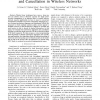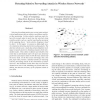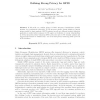746 search results - page 93 / 150 » Near-Optimal Radio Use for Wireless Network Synchronization |
INFOCOM
2010
IEEE
14 years 10 months ago
2010
IEEE
—Physical layer techniques have come a long way and can achieve close to Shannon capacity for single pointto-point transmissions. It is apparent that, to further improve network ...
159
click to vote
IPPS
2006
IEEE
15 years 6 months ago
2006
IEEE
Selective forwarding attacks may corrupt some missioncritical applications such as military surveillance and forest fire monitoring. In these attacks, malicious nodes behave like...
109
click to vote
PERCOM
2009
ACM
15 years 6 months ago
2009
ACM
—The primary function of a cognitive radio is to detect idle frequencies or sub-bands, not used by the primary users (PUs), and allocate these frequencies to secondary users. The...
PERCOM
2007
ACM
15 years 11 months ago
2007
ACM
In this work, we consider privacy in Radio Frequency IDentification (RFID) systems. Our contribution is threefold: (1) We propose a simple, formal definition of strong privacy usef...
109
click to vote
EWSN
2006
Springer
15 years 11 months ago
2006
Springer
Abstract. Sensor network devices have limited battery resources primarily consumed by radio communication. Network nodes play different communication roles and consequently consume...



